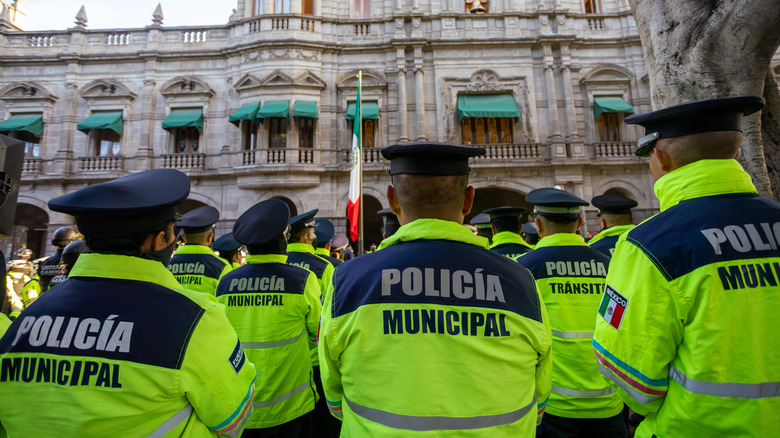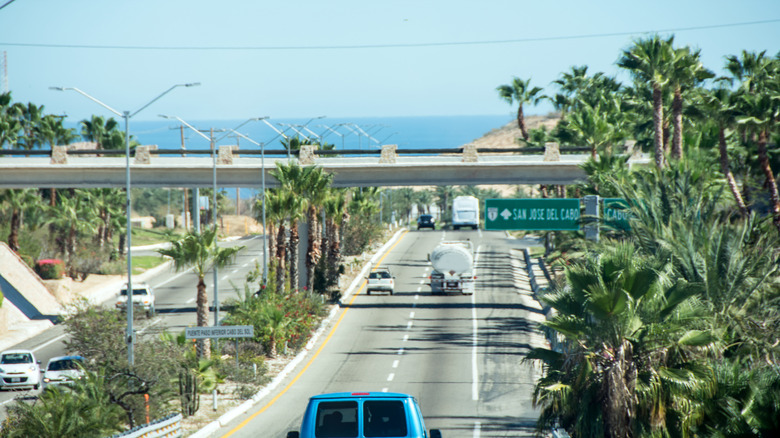 Stellalevi/Getty Images
Stellalevi/Getty Images
Mexico is a country with a rich cultural history, replete with incredible destinations stretching from the beaches of Playa del Carmen, Cabo San Lucas, and Cancún to the Mayan ruins of Tulum and the UNESCO World Heritage Site of Chichén Itzá. And let's not forget, it's where the Ford Mustang from the film "Bullitt" was eventually found. Unless you live in one of the border states like California, Arizona, New Mexico, or Texas, though, you probably never thought about driving straight into Mexico.
Back in the day, hopping over the border to Tijuana, Rosarito Beach, Nogales, or Juárez was just another thing to do on the weekend. Today, however, the U.S. State Department warns people need to be extra cautious when going there due to terrorism and violent crime, including the possibility of getting kidnapped for ransom. Even jaunts to places long thought relatively safe (Tijuana and Rosarito Beach) should be reconsidered, while some interior regions must be avoided entirely. Be sure to check the State Department's website before driving south of the border.
Still, it's completely doable if you're the adventurous type and take precautions. First and foremost, you should know that many driving habits, traffic signs, and laws you think you know of in the U.S. do not apply in Mexico, and not following them to the letter could get you arrested. Ending up imprisoned in another country isn't a picnic.
Don't just assume you know the law
 Josazano82/Shutterstock
Josazano82/Shutterstock
Traffic signs will be hard to decipher (like some of the confusing signs in the U.S.) if you're not familiar with the metric system and Spanish; ignorance of the law is not an excuse. "ALTO" is the Spanish word for stop, while others may warn of "CURVA PELIGROSA" (dangerous curve). Speed limits are displayed in kilometers per hour, not miles per hour (one mile equals 1.6 kilometers), so it's common to see numbers in the hundreds (105 kph is just over 65 mph).
In Mexico, you're guilty until proven innocent. If you get a traffic ticket or are involved in an accident, you'll be required to follow an officer to a judge and must pay your fine on the spot, so be sure to carry money. Violations can be costly and, if they're egregious enough, may result in your arrest and/or your car being towed. Getting it back will be difficult. Not only will you encounter a language barrier, but you'll face ambiguous protocols that'll likely require an expensive attorney or even the intervention of the U.S. Embassy.
Tijuana's police force says (per NBC San Diego) that traffic tickets issued to tourists increase by as much as 20% on weekends. Cutting in what can be lengthy lines while waiting to get back into the U.S. is the most common violation they see. Karim Chalita Rodriguez, president of the Tourism and Conventions Committee of Tijuana, said, "Americans either choose to ignore the law in Mexico or don't understand it." The State Department claims auto accidents are one of the leading causes of American deaths.
Passing other cars is weird and traffic lights blink
 Alejandro Munoz R/Shutterstock
Alejandro Munoz R/Shutterstock
Some odd traffic signals in Mexico might have you feeling like you're driving in the Upside Down. For instance, yellow lights mean you must stop, not simply slow down (or, in America, speed up). A blinking green light is actually similar to our yellow light and allows you to speed up through an intersection if needed. Meanwhile, turning right on a red light is never allowed.
A left-hand turn blinker may actually mean the driver is courteously letting you know it's safe to pass them. This is important because passing another vehicle in Mexico is different. When passing, the driver in the oncoming lane is expected to move over onto the shoulder (if one exists) and allow that vehicle to do so safely, which is a very different mentality from that in the U.S., where the act can sometimes feel like a scene from a Mad Max film.
Most importantly, your American-based auto insurance isn't valid in Mexico. Regardless of how high Consumer Reports ranks your insurance, you'll need to get Mexican Automobile Liability Insurance. Not having the proper coverage could result in your arrest, especially if you damage public property or injure someone. And if you're driving your own car, make sure the windows aren't tinted (especially in Baja), where they're considered illegal unless they came from the factory that way. Police in Tijuana have been known to let you remove the tint in front of them to avoid penalties.
Don't treat every road the same
 Wwing/Getty Images
Wwing/Getty Images
There are basically two types of roads you can use to get around Mexico, and each one will give you a far different perspective. "Libres" are the free, much older two-lane roads running through the country's more rural areas. They provide you with access to the area's more vibrant local culture. However, since they aren't maintained by any governing body, they're often in very rough shape, lack striping or signage, have very little (if any) lighting, and usually don't have shoulders. Accidents are far more likely to occur on these free roads.
Toll roads, often referred to as "autopista" or "cuotas," are maintained by Caminos y Puentes Federales (CAPUFE), Mexico's department of federal roads and bridges. Much like in the U.S. (where freeways are, in fact, different from highways), these modern three (or four) lane thoroughfares have a median, are well-lit, striped, and come with shoulders to pull over onto. The State Department strongly recommends sticking to these, mainly because they're far more frequently patrolled by police and are in much better condition.
Additionally, many roads have what are known as "topes." These speed bump elements aren't always highlighted with yellow paint like they are in America, and sometimes they don't have any warning signs. They can vary from gentle, barely noticeable humps to axle-breaking curb heights, so staying alert and obeying the posted speed limits is absolutely necessary. Good luck and travel safely. Mexico is waiting.


